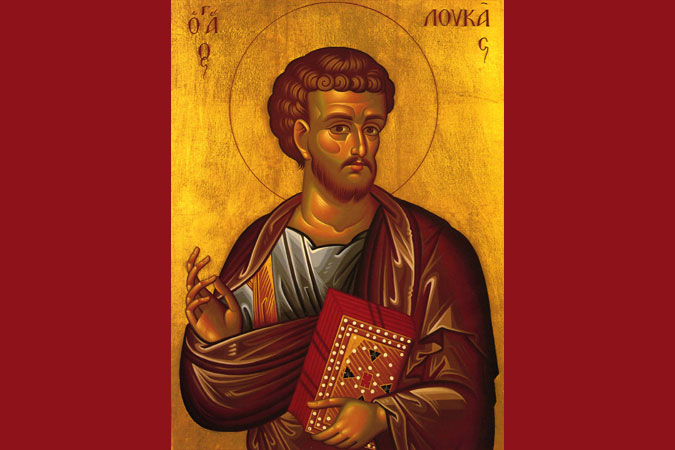
I hate to admit this, but I often give the saints short shrift in my faith-formation classes. Since I am helping ninth-graders prepare for the Sacrament of Confirmation, my focus is usually on having them pick a Confirmation name. To that end, I ask them to write a paper, produce a video, or perform a skit about a saint. If I can find the time, I will set aside a lesson in which I give them resources and guide them in researching the saints.
This never works. They usually pick the name of a saint who shares the name of a relative or a saint who is the patron of their favorite sport. (One year, I had three lacrosse players all pick the name Jean after St. Jean de Brébeuf, the patron saint of lacrosse.) No matter what their reason, they remember little—if anything—about the saint a year later.
How might I more effectively teach the saints in my classroom? Here are three ways based on the advice of St. Teresa of Ávila: “We need to study, to meditate upon, and to imitate those who, mortals like ourselves, performed such heroic deeds for God.”
Study some saints.
Most curriculum products will include brief biographies and activities on many different saints. I’ll dedicate time to sharing stories about the saints, but I’m going to skip the usual biographies. Instead, I’ll do a little research and tell the young people stories that I find personally interesting. (For example, my favorite story about St. Ignatius of Loyola is how he let a donkey make a decision for him.) By sharing stories that are important to me, I will demonstrate the impact that particular saint had on my life. Most importantly, I will ask the young people the question, “What does this story tell you about how the saint followed Christ?”
Meditate on the saints.
While I might teach young people a prayer attributed to a saint, such as the Suscipe or the Peace Prayer of St. Francis, this is not what St. Teresa meant by meditating on the saints. Rather, I will ask the young people to imagine that they were a particular saint today. What would they do? How would they act? What would be different about their lives, in the way they acted toward God, others, and themselves? Imaginative prayer can help the young people see the saints in a new light—not as historical figures long past, but as living teachers, who are interested in their lives today.
Imitate the saints.
This is the key to St. Teresa’s counsel. Studying and meditating on the saints is easy; imitating them is another thing altogether. I will ask the young people to brainstorm ways that they can do what the saint did and challenge them to act on those ideas before we meet again. I’ll invite them to consider their unique talents, abilities, personalities, and circumstances. Then, at our next session, we’ll spend a little time talking about what they did and the impact their actions had on them and others. The goal here is not to make the young people think of themselves as another St. Teresa, St. Ignatius, or St. Francis; rather, the goal is to help them discover the saint in themselves.
 Given the amount of material I have to cover in a given session, I might be a bit overzealous in thinking I can do this every time we meet. I might set a more modest goal of including a saint in one lesson each month. I will also encourage the young people to do this activity on their own, to learn about saints outside their classroom, ask themselves what this saint did for Christ, and how the young people might imitate him or her.
Given the amount of material I have to cover in a given session, I might be a bit overzealous in thinking I can do this every time we meet. I might set a more modest goal of including a saint in one lesson each month. I will also encourage the young people to do this activity on their own, to learn about saints outside their classroom, ask themselves what this saint did for Christ, and how the young people might imitate him or her.
“Always, in every place, one can become a saint,” Pope Francis said, “that is, one can open oneself up to this grace, which works inside us and leads us to holiness.” When I teach young people about the saints, I have to remember that I am not just teaching them about people; rather, I’m trying to help young people understand how they might open up themselves to God’s grace.
How do you help young people learn about the saints? How do you help them discover the saint within?
Bob is the author of Little Lessons from the Saints. See how Christ Our Life’s Gather and Go Forth pages bring the saints to life as models of evangelization for grades 1–8.





Hi Bob,
Thank you for sharing your ideas on helping youth “discover the saint in themselves”. I teach Salvation History in the Bible to 6th grade CCD students. We incorporate prayers and meditations from some of the Saints in specific lessons where God’s message or revelation to us touches on similar themes. For example, we meditate on and discuss the message behind St. Teresa of Avila’s “Christ has no body now on earth but yours” when we cover the Scripture accounts of the first Pentecost and the Ascension.
Another idea I implemented last year actually came to me during Eucharistic Adoration, so I have to give credit to Jesus for it. I give small treat bags to the youth during our final class of the year. I include a short personal note to each student, telling them about a special personality trait or talent which they demonstrated in class over the course of the year. I do some research to find a Saint who was known for that same trait or gift, and I tell the student just a little bit about that Saint. I include a prayer card for that Saint in their treat bag. I hope this small gesture helps the youth “discover the saint within”.
God bless you in your ministry!
I love your end of year idea! I shall pass that along to our catechists. Perhaps some of them will consider incorporating that as a practice 🙂
Well done, Bob! Thanks for helping catechists help children and youth on the road to sainthood.